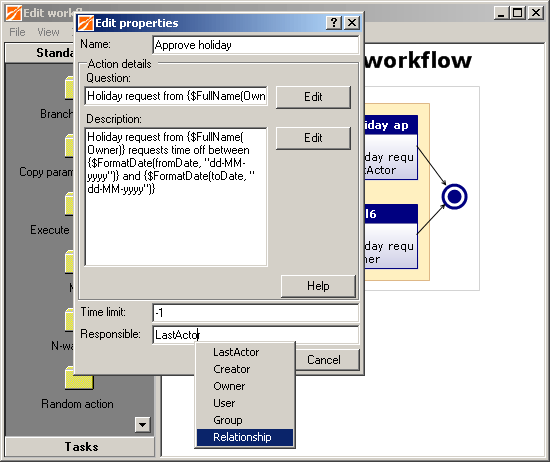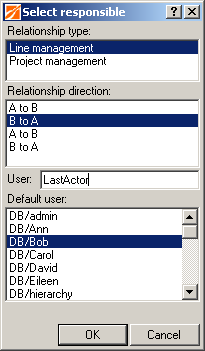|
|
||||||||||||||||||||||||||||||||||||
Responsible script |
||||||||||||||||||||||||||||||||||||
|
In order to select users and groups at various points in the system a responsible script is used. It provides various methods of selecting which user or group is to be used. By right clicking in text boxes that require responsible script, you are given a menu which helps author scripting commands.
|
||||||||||||||||||||||||||||||||||||
ExamplesIn this example we will assume that we have 3 users called Ann, Bob and Carol all in provider "DB". In terms of relationships, Ann manages Bob and Bob manages Carol. Bob and Carol are both in the "Development" group.Example 1: Select a user by name.
Script: User("DB/Ann") Output: User called Ann from provider DB. This is a trivial example that requires little explanation. In general it is not good practice to assign tasks to users, it is better to assign them to groups or to users who have been selected in parameters (see below). Example 2: Select a group by name.
Script: Group("Development") Output: Group called Development. This example returns a group rather than a user, while not every area of the system can operate with groups they are used by activities, and tasks can be assigned to groups rather than individuals. Example 3: Get owner of the workflow.
Script: Owner Output: Returns the owner of the workflow This command returns the owner of the workflow Example 4: Get user from a parameter.
Script: Param("requestedReviewer") Output: User or group who is specified in the field "requestedReviewer" of the parameters of the workflow This is the way to access the parameters of the workflow and get a user or group from them. Example 5: Gets a user from a relationship.
|
||||||||||||||||||||||||||||||||||||
Command reference
|
||||||||||||||||||||||||||||||||||||
|
Did you find this article helpful? Comments on this page are welcome and can only help us improve the quality of our documentation.
© Ant Organisation Ltd, 2003
|



